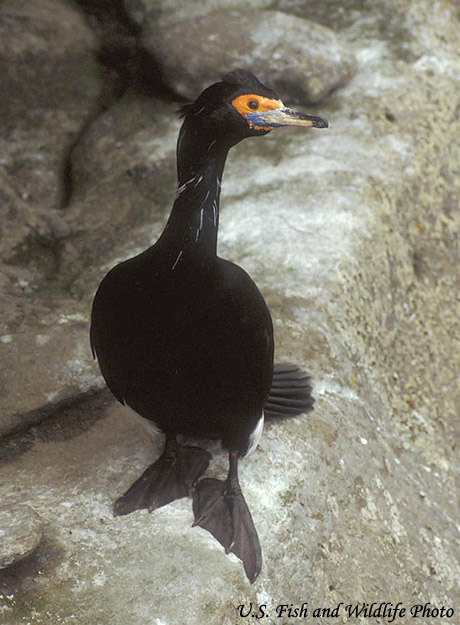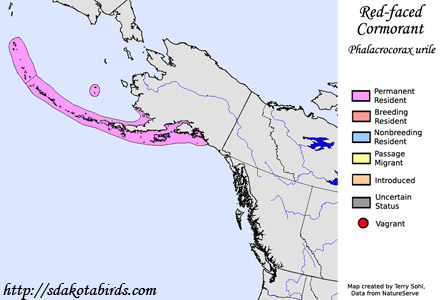| Length: 28 inches | Wingspan: 46 inches | Seasonality: Non-resident in South Dakota |
| ID Keys: Dark plumage overall, adults with red face (breeding), orangish-red face (non-breeding) | ||
 The
Red-faced Cormorant is a bird not seen by most birders, as their only range
in North America is along the Aleutian Island chain, extending eastward
along the southern Alaskan coast. They are named for the bare colored
patch of skin on the face, which becomes much bolder in color during the
breeding season. The species is also found on the western side of the
Pacific, where they nest from coastal Russia southward to the northern parts
of the Sea of Japan.
The
Red-faced Cormorant is a bird not seen by most birders, as their only range
in North America is along the Aleutian Island chain, extending eastward
along the southern Alaskan coast. They are named for the bare colored
patch of skin on the face, which becomes much bolder in color during the
breeding season. The species is also found on the western side of the
Pacific, where they nest from coastal Russia southward to the northern parts
of the Sea of Japan.
Habitat: During the summer breeding season, colonies form on steep cliff faces or other steep rocky slopes. Generally stays relatively close to breeding colonies outside of nesting season as well, prefering to forage in shallower waters near their island coastlines.
Diet: Feeds heavily on fish, but will also sometimes eat crustaceans and other marine creatures.
Behavior: Forages by swimming underwater in search of prey. They typically swim along the water's surface, occasionally putting their head underwater, and then diving underwater and propelling themselves with their feet when prey is spotted. Generally forages alone.
Nesting: The nest of a Red-faced Cormorant is a mound of seaweed, mosses, grass, and other vegetative material, cemeted together with the bird's own waste, with a depression in the center. The nest is built on a cliff ledge or other steep rocky slope. The female lays 3 to 4 eggs, and both the male and female help incubate them. Both parents help to feed the nestlings after the eggs hatch.
Song: Has a low croaking sound, typically only heard on breeding colonies. When away from breeding colonies, they are usually silent.
Migration: Considered a permanent resident throughout its range.
Interactive eBird Map: Click here to access an interactive eBird map of Red-faced Cormorant sightings
Similar Species: In range, most likely to be confused with Double-crested Cormorant, Pelagic Cormorant.
Conservation Status: Populations of Red-faced Cormorants are considered stable at a global level, with a range that may have increased eastward in the latter half of the 20th century to parts of southern Alaska. However, North American birds nesting in the western Aleutians have experienced declines in recent decades. Introduced fox populations on some Aleutian Islands have undoubtedly had a negative impact on breeding success of Red-faced Cormorants. Overall however, the IUCN lists the Red-faced Cormorant as a species of "Least Concern."
Further Information: 1) Alaska Seabird Information Series - Red-faced Cormorant
2) Audubon Guide - Red-faced Cormorant
3) USGS Patuxent Bird Infocenter - Red-faced Cormorant
Photo Information: Photo by U.S. Fish and Wildlife (Public Domain)
| Click below for a higher-resolution map |
 |
| South Dakota Status: Non-resident in South Dakota |
Additional Red-faced Cormorant Photos (coming soon!!)
